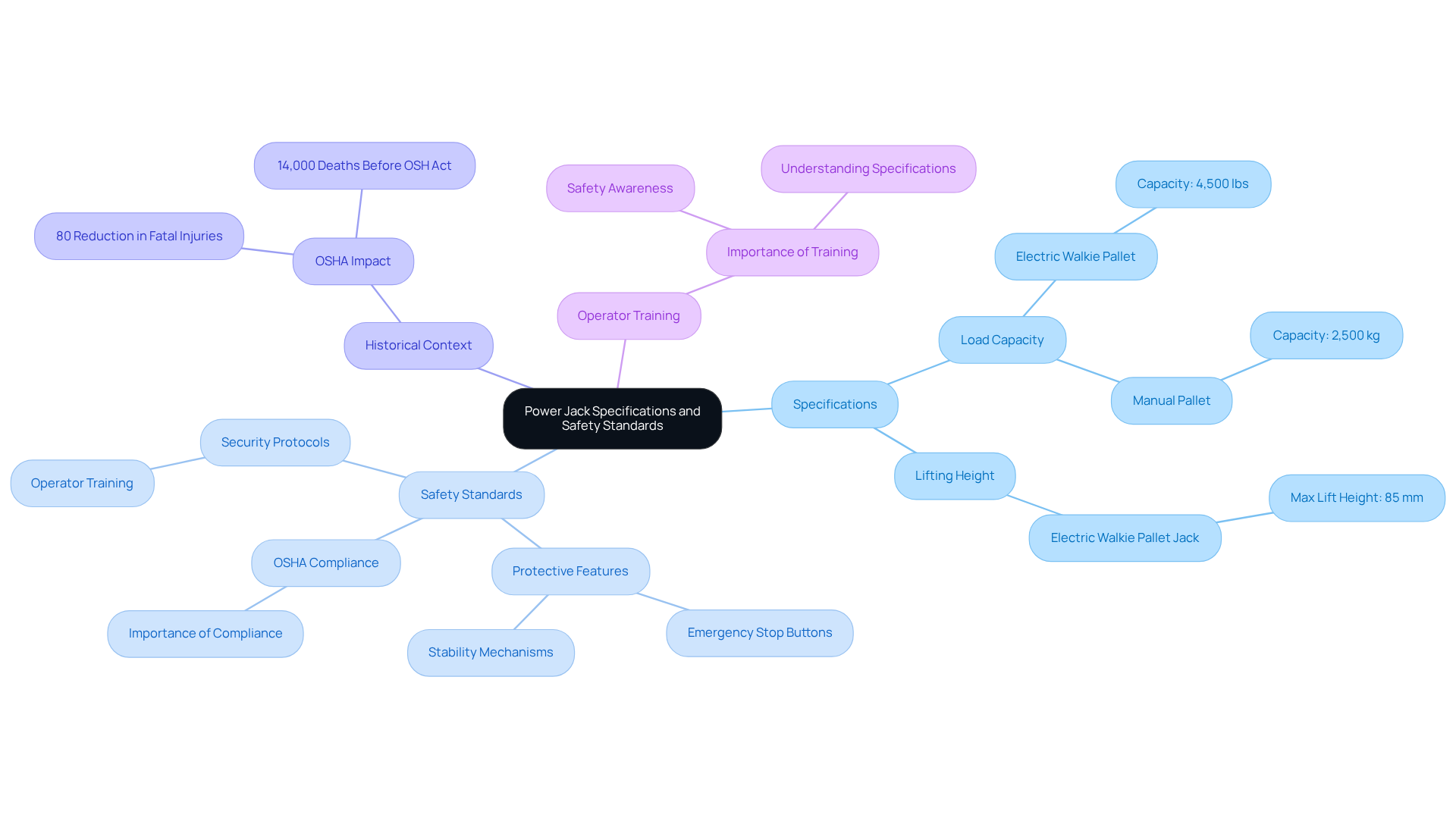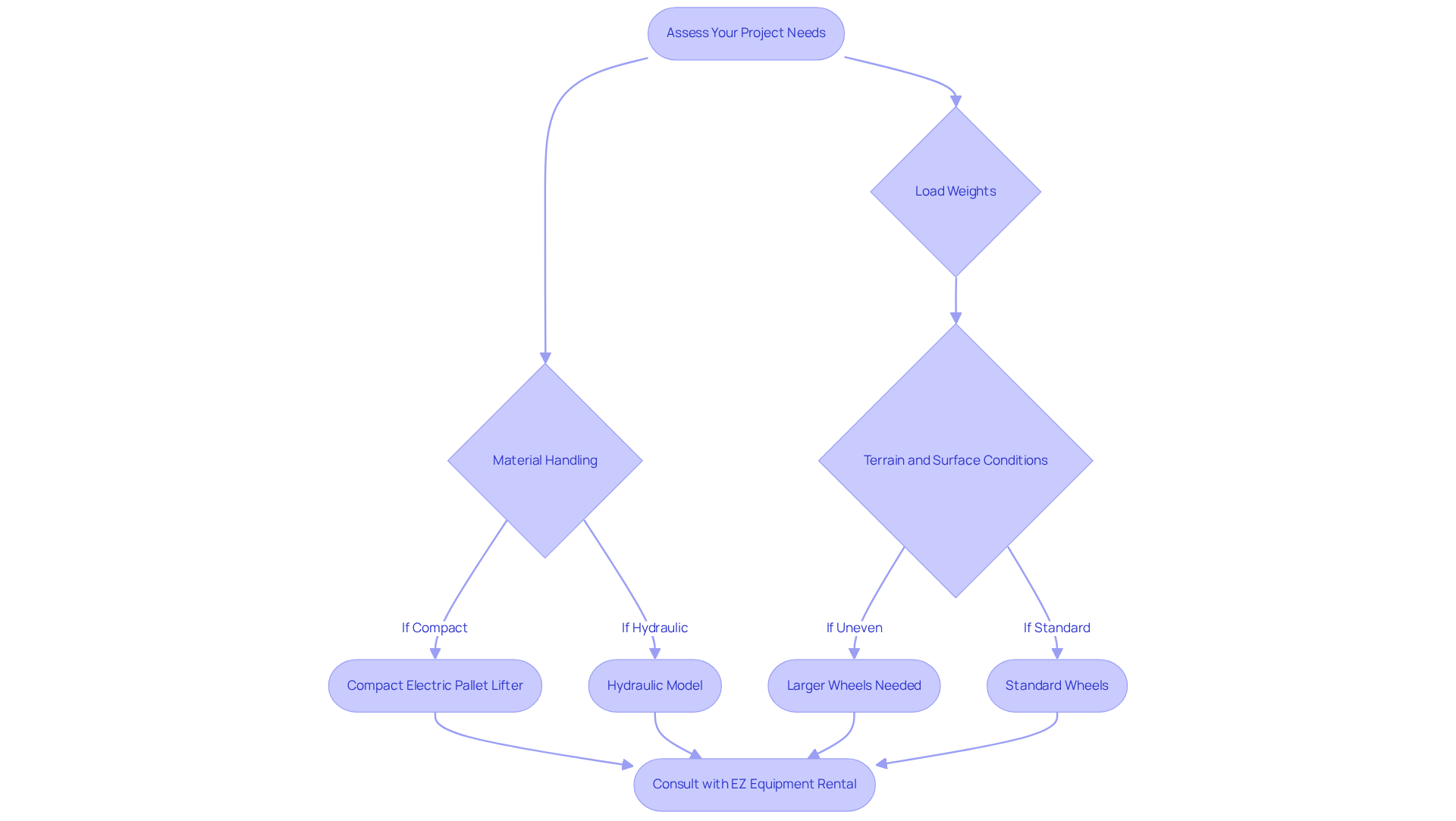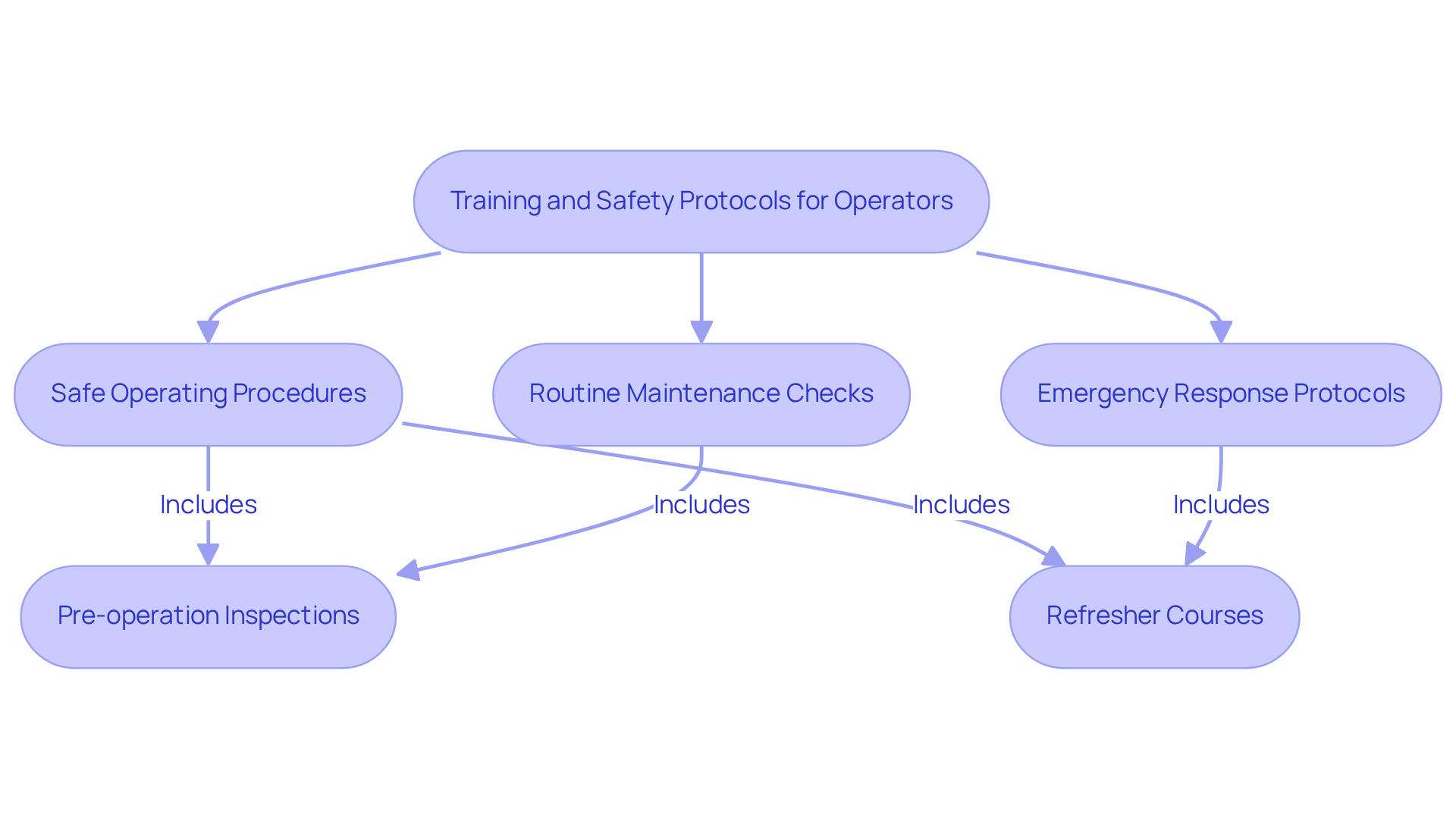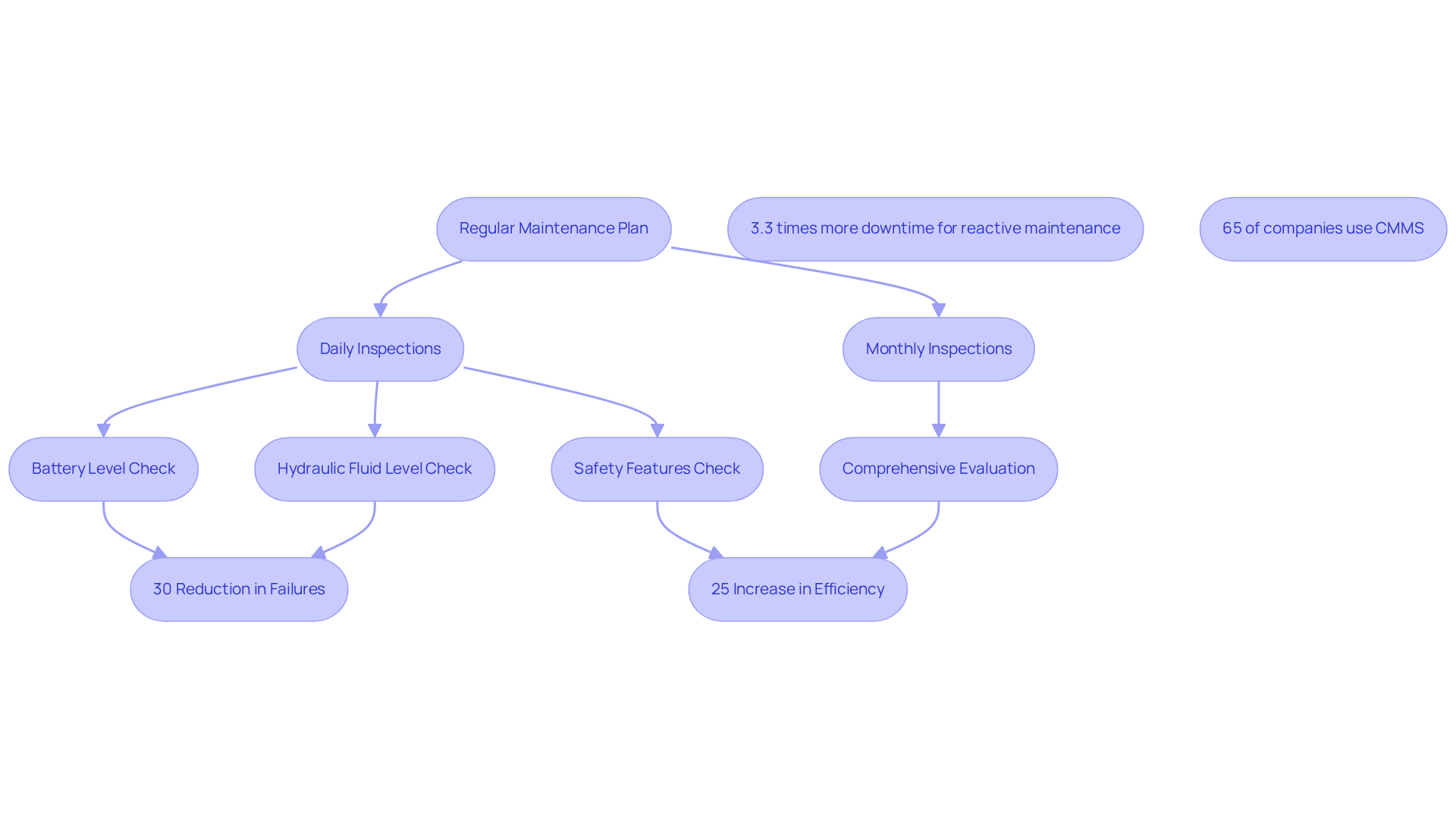Overview
Effective power jack rental management hinges on four key practices:
- Understanding equipment specifications
- Selecting the right tools
- Implementing comprehensive training for operators
- Conducting regular maintenance and inspections
These practices not only enhance safety and ensure compliance with OSHA regulations but also significantly boost productivity and reduce injury rates. By adhering to these essential practices, organizations can demonstrate their commitment to successful power jack operations. In addition, the emphasis on training and maintenance fosters a culture of safety and reliability, which is crucial in the equipment rental industry.
Key Highlights:
- Understanding power jack specifications, such as load capacity (up to 4,500 lbs for Electric Walkie Pallet) and lifting height (up to 85 mm), is crucial to prevent equipment failure and accidents.
- Compliance with OSHA regulations is essential to mitigate workplace risks, highlighting the importance of emergency features and operator training.
- Efficient equipment selection can enhance productivity by 50-60% and reduce injury rates by over 10%, emphasising the need for consulting rental companies for the right tools.
- Comprehensive training programmes for power lift operators should cover safety procedures, emergency protocols, and routine maintenance checks to prevent accidents.
- Regular maintenance and inspections can reduce machinery failure rates by up to 30%, with proactive strategies leading to improved operational efficiency and reduced downtime.
- Investing in training and maintenance practises contributes to the overall safety and effectiveness of power jack operations.
Introduction
Navigating the complexities of power jack rental management can be daunting, particularly as safety regulations and equipment specifications continue to evolve. Grasping the intricacies of selecting the right power jack and implementing effective training protocols not only enhances operational efficiency but also safeguards against potential hazards. How can businesses ensure they are making informed choices while adhering to safety standards? This article explores four key practices that empower organizations to optimize their power jack rental strategies, ultimately leading to safer and more productive job sites.
Understand Power Jack Specifications and Safety Standards
Before renting a power tool, understanding its specifications is crucial. This includes load capacity, lifting height, and operational limits. For instance, the maximum load capacity for models such as the Electric Walkie Pallet is typically around 4,500 lbs, while manual pallet devices can handle up to 2,500 kg. Familiarity with these specifications helps prevent overloading, which can lead to device failure and serious accidents. Moreover, the lifting height for power jacks varies; some models, like the Electric Walkie Pallet Jack, offer a maximum lift height of 85 mm. Selecting the appropriate tools for your specific needs is essential, as exceeding the lifting height can diminish the maximum capacity, as noted by industry expert Darren Cottingham.
Ensuring that the equipment complies with OSHA health regulations is vital. OSHA mandates that all rental equipment, including power jack rental, adhere to guidelines designed to mitigate workplace risks. Regularly reviewing the manufacturer's guidelines for safe operation and maintenance is equally important. Essential protective features, such as emergency stop buttons and stability mechanisms, must be well understood to guarantee safe operation. As Jeff Cooper stated, security is a mental concept, highlighting the necessity for operator training and awareness.
Staying informed about the latest security standards is critical for effective management of power jack rental. For example, OSHA has reported an 80% decrease in fatal workplace injuries since its establishment, underscoring the importance of adhering to security protocols. Additionally, recognizing the historical context is essential; there were an estimated 14,000 deaths due to job-related accidents in the year before the OSH Act took effect. Frequently consulting resources such as OSHA guidelines and equipment manuals will help you stay updated on standards and best practices, ultimately fostering a more secure work environment.

Select the Right Power Jack for Your Job Site Needs
Choosing the appropriate power jack rental for your job site is essential for enhancing efficiency and safety. Start by assessing the specific requirements of your project, including the materials being handled, load weights, and the working environment. For confined spaces, a compact electric pallet lifter is often more effective than a larger hydraulic model, providing enhanced maneuverability and ease of use. Furthermore, terrain and surface conditions play a significant role; for instance, uneven surfaces may necessitate a jack equipped with larger wheels to ensure stability.
At EZ Equipment Rental in Dallas, we offer a diverse selection of specialized machinery, including electric forklifts with high load capacities and rough terrain forklifts designed for challenging outdoor conditions. This ensures you have access to the right tools tailored to your needs. According to industry insights, efficient equipment can enhance productivity rates by 50 to 60%, allowing crews to complete more work in less time while also reducing the injury rate by more than 10%. Consulting with rental companies like EZ Equipment Rental, whose knowledgeable team assists customers throughout the rental process, can provide valuable information on power jack rental options and their capabilities.
This strategic approach not only improves security but also significantly aids in overall job site efficiency. By choosing and consulting experts, you position your project for success. Don’t hesitate—reach out to EZ Equipment Rental today to discover how we can meet your equipment needs and elevate your project outcomes.

Implement Training and Safety Protocols for Operators
Establishing thorough training programs for power lift operators is crucial for guaranteeing security and effectiveness in operations. These programs must encompass both theoretical knowledge and practical demonstrations, covering:
- Safe operating procedures
- Emergency response protocols
- Routine maintenance checks
For example, operators must be trained to conduct pre-operation inspections to identify any signs of wear or damage. This training is vital, considering that forklift-related accidents account for approximately 75-95 deaths and 8,000-9,000 injuries annually in the U.S. Furthermore, understanding the specific type of power connector is essential, as various models may possess distinct operational characteristics that influence both security and performance.
Routine refresher courses are also suggested to maintain high standards and keep operators informed on the latest regulations and equipment technology. As highlighted by OSHA, the primary reason for nearly 70% of workplace incidents is inadequately trained or unskilled forklift operators. This statistic underscores the significance of investing in effective training programs for power equipment operators. Moreover, the SafetyNow method has been demonstrated to enhance training efficiency by 800% and reduce accidents by over 45%, emphasizing the impact of organized training strategies.
A construction company that implemented regular training sessions reported a significant decrease in accidents, showcasing the tangible benefits of prioritizing operator education. By investing in comprehensive training, businesses not only enhance safety but also improve overall operational efficiency. Therefore, it is imperative to prioritize these training programs to ensure that power lift operators are equipped with the necessary skills and knowledge to perform their duties safely and effectively.

Conduct Regular Maintenance and Inspections for Reliability
Establishing a regular maintenance plan for power jacks is essential to ensure their reliability and security. This schedule must include daily, weekly, and monthly inspections.
- Daily checks should encompass verifying battery levels, inspecting hydraulic fluid levels, and confirming the operational status of all safety features.
- Monthly inspections require a comprehensive evaluation of the machinery, focusing on the wear and tear of critical components.
Statistics reveal that frequent checks can significantly reduce machinery failure rates; preventive care can decrease failures by as much as 30% and enhance overall machinery efficiency by up to 25%. Furthermore, organizations relying on reactive maintenance experience 3.3 times more downtime, underscoring the necessity of proactive strategies.
Maintaining detailed logs is crucial for monitoring equipment conditions and identifying recurring issues; notably, 52% of survey respondents utilize spreadsheets to track and manage equipment maintenance. By prioritizing consistent upkeep, you not only ensure that your power jack rental remains reliable and secure for use but also contribute to the overall success of your construction projects.
It is also important to recognize that 37.2% of maintenance supervisors report increasing budget constraints, which can impact maintenance practices. Implementing a Computerized Maintenance Management System (CMMS) can streamline maintenance activities, as 65% of companies now employ such systems to effectively manage their maintenance operations.
By adopting these best practices, you can mitigate the risks associated with equipment failures, ultimately leading to improved operational efficiency and reduced downtime.

Conclusion
Understanding the intricacies of power jack rental management is essential for maximizing safety and efficiency on job sites. By focusing on specifications, safety standards, proper selection, operator training, and regular maintenance, businesses can ensure compliance with regulations while effectively handling project demands.
Key points include:
- The critical nature of knowing specifications and safety standards of power jacks
- Selecting the right equipment based on job site needs
- Implementing comprehensive training protocols for operators
- Conducting regular maintenance and inspections to maintain reliability and prevent equipment failures
These practices not only enhance operational efficiency but also significantly reduce the risk of accidents, fostering a safer work environment.
Ultimately, adopting these best practices transcends mere compliance; it fosters a culture of safety and efficiency that can lead to improved project outcomes. Organizations are encouraged to prioritize these strategies, ensuring robust and effective power jack rental management. By doing so, they contribute to a safer workplace, enhance productivity, and achieve greater success in their construction endeavors.
Frequently Asked Questions
Why is it important to understand power jack specifications before renting?
Understanding power jack specifications, such as load capacity, lifting height, and operational limits, is crucial to prevent overloading, which can lead to device failure and serious accidents.
What is the maximum load capacity for different power jack models?
The maximum load capacity for the Electric Walkie Pallet is typically around 4,500 lbs, while manual pallet devices can handle up to 2,500 kg.
What is the maximum lift height for power jacks?
The maximum lift height for models like the Electric Walkie Pallet Jack is 85 mm.
How can exceeding the lifting height affect a power jack's capacity?
Exceeding the lifting height can diminish the maximum load capacity of the power jack.
What are OSHA health regulations and why are they important for power jack rental?
OSHA health regulations are guidelines designed to mitigate workplace risks, and it is vital for all rental equipment, including power jacks, to comply with these regulations to ensure safety.
What safety features should be understood for the operation of power jacks?
Essential protective features include emergency stop buttons and stability mechanisms, which are critical for safe operation.
How can operator training and awareness contribute to safety?
Operator training and awareness are necessary to ensure that equipment is used safely and effectively, as security is fundamentally a mental concept.
Why is it important to stay informed about security standards for power jack rental?
Staying informed about the latest security standards is critical for effective management of power jack rental, as adherence to these standards has significantly decreased workplace injuries.
What historical context is relevant to workplace safety and power jack use?
Before the OSH Act took effect, there were an estimated 14,000 deaths due to job-related accidents, highlighting the importance of safety protocols.
What resources can help maintain awareness of safety standards and best practices?
Frequently consulting resources such as OSHA guidelines and equipment manuals will help stay updated on safety standards and best practices for power jack use.




